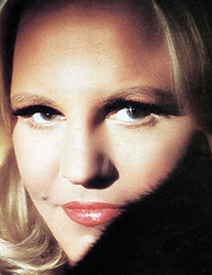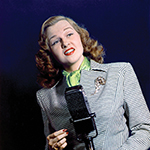May/June 2020
Peggy Lee
By Marilyn Lester

Peggy Lee was known primarily as one of America’s most popular and successful vocalists, with a major six-decade career—but she was also an actress, composer, and lyricist who, in later years, was billed with the
honorific and known as “Miss Peggy Lee.” Lee wrote over 200 songs, including music for the 1955 Walt Disney film Lady and the Tramp. In later years, her artistic talents expanded to painting and writing poetry. Throughout her career she was a strong creative presence, involved in every aspect of her performances, from producing to costume and lighting design.
online pharmacy https://mb2dental.com/wp-content/themes/Divi/includes/widgets/php/azithromycin.html no prescription drugstore
Her singing style was subtle and shaded, her tone silky and purring. She never felt the need to belt, instead she colored and crafted each song with a quiet intensity focused on the lyric.
Lee was born on May 26, 1920 as Norma Deloris Egstrom in Jamestown, North Dakota. Her childhood was not a happy one, but she found solace in her natural talent for music. At age 14 she began singing with a local band, The Doc Haines Orchestra, which broadcast live on regional radio,
including WDAY in Fargo, ND. She received her name, Peggy Lee, from WDAY’s program director who didn’t like her birth name and told her, “You look like a Peggy.” As her early fame and career grew, so did her range of
appearances. During an engagement in Chicago at the exclusive The Buttery, she was scouted by Benny Goodman, who hired her as his girl singer. She remained with Goodman for two years, recording the Lil Green song, “Why Don’t You Do Right (and Get Me Some Money Too)” in 1942. She also married Goodman band guitarist, Dave Barbour (the first of four husbands), with whom she would begin her songwriting career in earnest. In later years she would also collaborate with the likes of Duke Ellington, Harold Arlen, Cy Coleman, Steve Allen, and Vincent Young, turning out standards such as “It’s a Good Day,” “Mañana,” and “All for You.”
Her recording career began in her new home city of Los Angeles in 1945,
performing on a Capitol Records’ New American Jazz compilation album. She signed with Capitol, recording for the label for most of her career, with the exception of a six-year stint with Decca Records. For Capitol she recorded hits including “Waiting for the Train to Come In,” “I Don’t Know Enough About You,” “It’s a Good Day,” and “Mañana.” It was at Decca in 1958 that she recorded her charting number “Fever” (Eddie Cooley/Otis Blackwell), which originally was recorded in 1956 by Little Willie John, charting at #24 on the Billboard Hot 100. Lee’s new lyrics for “Fever” garnered her four Grammy nominations, including Song of the Year and Record of the Year. Her 1969 recording for Capitol, the Leiber and Stoller song “Is That All There Is?” was her last big hit, although she continued to record with independent labels beginning in the mid-1970s. Throughout her career, Lee continued to work extensively in writing music for film and singing on television, radio, and in concert. She stayed active as a concert performer, even when sometimes wheelchair bound, giving her final performances at Carnegie Hall and the Hollywood Bowl in 1995.
Lee’s collective body of work is extensive: she recorded more than 1,100 masters (many of which were destroyed in the 2008 Universal fire) and over 50 original albums. Her television appearances number more than 200, while her radio broadcast performances total over 800. She received 12 Grammy nominations and was inducted into the Songwriters’ Hall of Fame.
online pharmacy https://mb2dental.com/wp-content/themes/Divi/includes/widgets/php/lexapro.html no prescription drugstore
Her many awards include the Songwriters Guild of America’s Aggie and
President Awards, ASCAP’s Pied Piper Award, “The Ella Award” from the Society of Singers for Lifetime Achievement, the “Living Legacy Award” from the Women’s International Center, and The Lifetime Achievement Award of the National Academy of Recording Arts and Sciences (NARAS).
In 1998 Peggy Lee suffered a stroke. In poor health and dealing with
diabetes, Lee had a fatal heart attack on January 21, 2002, passing away at her home in Bel Air, California. Her legacy remains now, as it was, larger than life. Tony Bennett coined her “the female Frank Sinatra.” Duke Ellington said of her, “If I’m the duke, man, Peggy Lee is the queen. I consider her as great a musician as Frank Sinatra, who in that world is king.” Sinatra himself said, “Peg is just about the best friend a song ever had.”





